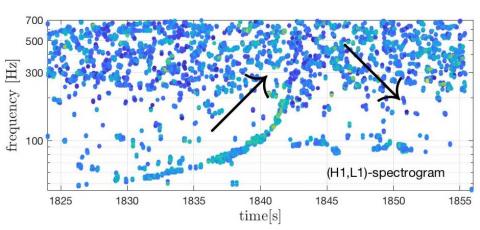For the first time astronomers have detected gravitational waves from a merged, hyper-massive neutron star. The scientists, Maurice van Putten of Sejong University in South Korea, and Massimo della Valle of the Osservatorio Astronomico de Capodimonte in Italy, publish their results in Monthly Notices of the Royal Astronomical Society: Letters.
Gravitational waves were predicted by Albert Einstein in his General Theory of Relativity in 1915. The waves are disturbances in space time generated by rapidly moving masses, which propagate out from the source. By the time the waves reach the Earth, they are incredibly weak and their detection requires extremely sensitive equipment. It took scientists until 2016 to announce the first observation of gravitational waves using the Laser Interferometer Gravitational Wave Observatory (LIGO) detector.
Since that seminal result, gravitational waves have been detected on a further six occasions. One of these, GW170817, resulted from the merger of two stellar remnants known as neutron stars. These objects form after stars much more massive than the Sun explode as supernovae, leaving behind a core of material packed to extraordinary densities.
At the same time as the burst of gravitational waves from the merger, observatories detected emission in gamma rays, X-rays, ultraviolet, visible light, infrared and radio waves – an unprecedented observing campaign that confirmed the location and nature of the source.
The initial observations of GW170817 suggested that the two neutron stars merged into a black hole, an object with a gravitational field so powerful that not even light can travel quickly enough to escape its grasp. Van Putten and della Valle set out to check this, using a novel technique to analyse the data from LIGO and the Virgo gravitational wave detector sited in Italy.

Their detailed analysis shows the H1 and L1 detectors in LIGO, which are separated by more than 3,000 kilometres, simultaneously picked up a descending ‘chirp’ lasting around 5 seconds. Significantly, this chirp started between the end of the initial burst of gravitational waves and a subsequent burst of gamma rays. Its low frequency (less than 1 KHz, reducing to 49 Hz) suggests the merged object spun down to instead become a larger neutron star, rather than a black hole.
There are other objects like this, with their total mass matching known neutron star binary pairs. But van Putten and della Valle have now confirmed their origin.
Van Putten comments: “We’re still very much in the pioneering era of gravitational wave astronomy. So it pays to look at data in detail. For us this really paid off, and we’ve been able to confirm that two neutron stars merged to form a larger one.”
Gravitational wave astronomy, and eking out the data from every detection, will take another step forward next year, when the Japanese Kamioka Gravitational Wave Detector (KAGRA) comes online.
Media contacts
Dr Robert Massey
Royal Astronomical Society
Tel: +44 (0)20 7292 3979
Mob: +44 (0)7802 877 699
Dr Morgan Hollis
Royal Astronomical Society
Tel: +44 (0)20 7292 3977
Mob: +44 (0)7802 877 700
Science contacts
Prof. Maurice van Putten
Physics and Astronomy
Sejong University
Seoul
Korea
Images and captions


Further information
The new work appears in: “Observational evidence for Extended Emission to GW170817”, M.H.P.M. van Putten and M. Della Valle, Monthly Notices of the Royal Astronomical Society: Letters (2019), 482 (1) (DOI: 10.1093/mnrasl/sly166).
A copy of the paper is available from: https://doi.org/10.1093/mnrasl/sly166
Notes for editors
The Royal Astronomical Society (RAS, www.ras.ac.uk), founded in 1820, encourages and promotes the study of astronomy, solar-system science, geophysics and closely related branches of science. The RAS organizes scientific meetings, publishes international research and review journals, recognizes outstanding achievements by the award of medals and prizes, maintains an extensive library, supports education through grants and outreach activities and represents UK astronomy nationally and internationally. Its more than 4,000 members (Fellows), a third based overseas, include scientific researchers in universities, observatories and laboratories as well as historians of astronomy and others.
The RAS accepts papers for its journals based on the principle of peer review, in which fellow experts on the editorial boards accept the paper as worth considering. The Society issues press releases based on a similar principle, but the organisations and scientists concerned have overall responsibility for their content.
Twitter: https://twitter.com/royalastrosoc
Facebook: https://facebook.com/royalastrosoc
Instagram: https://www.instagram.com/royalastrosoc/
YouTube: https://www.youtube.com/user/RoyalAstroSoc/feed

